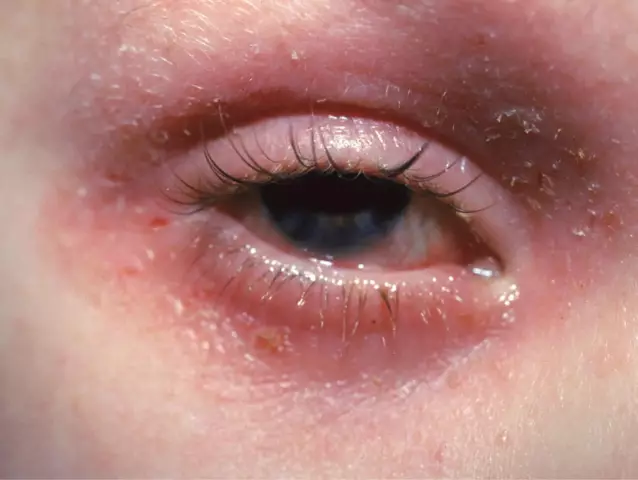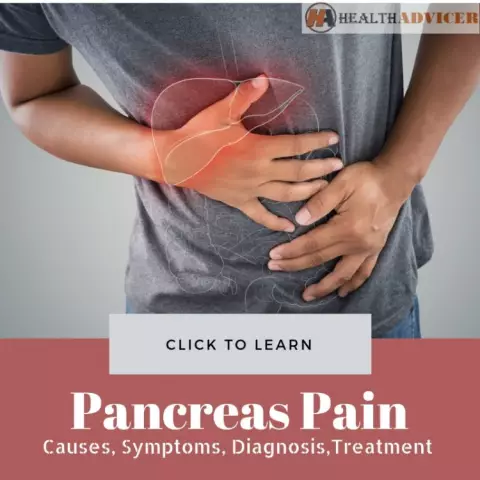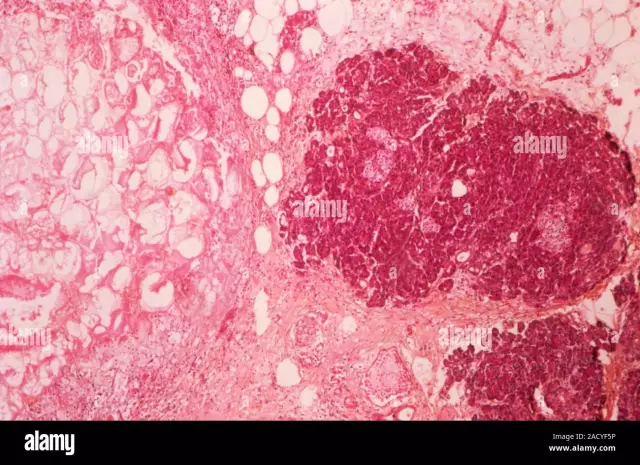- Author Rachel Wainwright [email protected].
- Public 2023-12-15 07:39.
- Last modified 2025-11-02 20:14.
Pancreas
The pancreas is a large endocrine and digestive gland located behind the stomach, at the level of the upper thoracic and lower lumbar vertebrae. The pancreas weighs 70-80 g, its length is 10-23 cm, width in the region of the head is 3-9 cm, thickness is 2-3 cm.

The structure of the pancreas
This organ consists of three main sections: the head with the hooked process, the body and tail - the narrowest part of the gland. Between the body and the head is the narrowed part of the gland - the neck.
The hammer-shaped head of the gland is placed in the arch of the duodenum. There are blood vessels behind the head.
The body of the gland with its posterior surface is in contact with the left kidney, retroperitoneal tissue and adrenal gland, bending around the spine at the level of the first and second vertebrae of the lumbar spine.
The tail of the pancreas is usually narrow, slightly rounded and raised upward. There is a small depression at the point of contact of the tail with the fundus of the stomach.
In the thickness of the gland (from the head to the tail), there is a duct that flows into the duodenum.
In the structure of this organ, two types of tissue are distinguished - parenchyma (glandular tissue) and stroma (connective tissue). The parenchyma of the gland is represented by numerous lobules of an irregular shape, as well as cell areas that have a rounded shape (islets of Langerhans). The glandular (secretory) cells of the lobules produce pancreatic (pancreatic) juice. This secret contains the most important food enzymes - trypsin, lipase, amylase. Islet cells synthesize hormones (glucagon and insulin).
Pancreatic functions
This gland, being an organ of external and internal secretion, simultaneously performs exocrine and endocrine functions.
The pancreas is involved in the digestion process. The part of the gland involved in digestion through the main duct produces pancreatic juice directly into the duodenum. The exocrine portion of the gland secretes 0.5-0.7 liters of gastric juice in humans throughout the day.
The action of the islets of Langerhans is similar to that of the endocrine glands. They release insulin and glucagon into the bloodstream, hormones that regulate carbohydrate metabolism. Insulin is anabolic. In addition, it promotes the formation of triglycerides from fatty acids by lipocytes and hepatocytes. Glucagon has a similar effect, but it simultaneously stimulates the oxidation of triglycerides in hepatocytes, contributing to the formation of ketone bodies. A constant blood glucose level in the range of 800-1000 mg / L is regulated by glucagon and insulin.
Diseases of the pancreas
Inflammation of the pancreas can occur as a result of alcohol abuse, spicy, fried and fatty foods. Inflammation can also be caused by frequent stress and overeating.
Inflammation of the pancreas can occur in both acute and chronic forms (chronic and acute pancreatitis).
Inflammation in a chronic form often develops into very dangerous diseases of the pancreas - cyst, tuberculosis, abscess, diabetes mellitus, pancreatic cancer.
Inflammation of the pancreas is sometimes the result of various infectious diseases, parasitic infestations, collegiate diseases, metabolic diseases. Diseases of the tongue and gums increase the risk of developing pancreatic cancer.
The clinical manifestations of pancreatic diseases include loss of appetite, the appearance of red spots on the skin of the chest, abdomen, back, a sharp decrease or increase in body temperature, vomiting, nausea, dry skin, brittle hair and nails, belching.
Pancreas treatment
During the period of remission, as well as during recovery (after previous exacerbations), it is very important to follow a diet to prevent relapses and treat the pancreas.
In addition to the diet, the patient is usually prescribed medication for the pancreas: medications that reduce enzyme activity, relieve spasm of the smooth muscles of the ducts of the gland, as well as sedatives and pain relievers.
Benign tumors (fibromas, adenomas, lipomas) are most often removed surgically. Pancreatic cancer is also treated with surgery followed by chemotherapy and postoperative radiation.
Distinguish between palliative and radical surgery. To radical operations include resection of the tail and body of the gland, pancreatoduodenal resections, total pancreatoduodenectomy. Palliative operations are performed to improve the quality of life of patients and are aimed at eliminating obstructive jaundice, pain syndrome, and duodenal obstruction.
Found a mistake in the text? Select it and press Ctrl + Enter.






